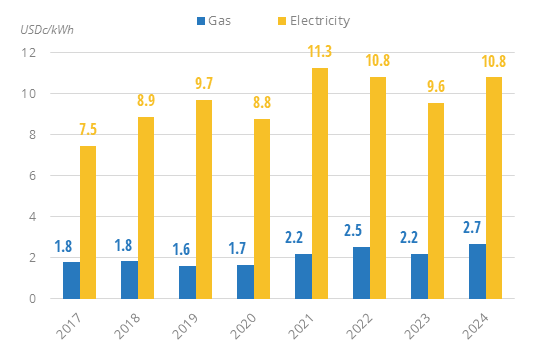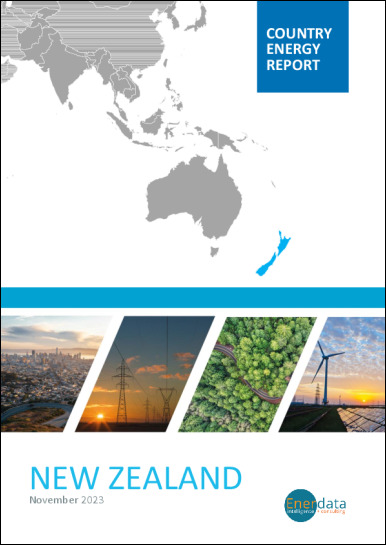- Update
-
- Format
- 3 files (PDF report, 2 Excel files)
- Pages
-
54 (Report only)
- Delivery
- Immediate by e-mail
- GENERAL OVERVIEW
- ENERGY AND CLIMATE POLICY FRAMEWORK
- ENERGY COMPANIES
- ENERGY SUPPLY AND DEMAND
- ENERGY USE AND PRICE BY SECTOR
- ISSUES AND PROSPECTS
- STATISTICS
- ABBREVIATIONS
- GLOSSARY
Buy New Zealand energy report
Price without VAT. Depending on your statute and location, VAT might be applicable. Get in touch with us for more information.
After validation, you will immediately receive 3 files by email (one pdf report and 2 excel files containing the datasets).
Overview
New Zealand pursues ambitious climate goals, targeting carbon neutrality by 2050 with strong renewable energy expansion, including a 90% renewable electricity share. Key policies include emissions reduction plans, offshore exploration reinstatement, and sector-specific decarbonisation measures, supported by regulatory bodies and market reforms.
Get more details on the table of contents and data files, as well as the list of graphs and tables by browsing the tabs below.
Highlights
- The country targets a 90% share of renewables in the electricity mix in 2025 and a 51-55% reduction in GHG emissions in 2035.
- The country aims to become carbon neutral by 2050.
- Offshore exploration was reauthorised in 2025.
- Four companies account for around 80% of the power generation: Meridian, Mercury, Contact Energy, and Genesis Energy.
- Renewables accounted for 85% of the power mix in 2024 (+11 pp since 2010) and for 46% of total energy supply (+6 pp).
- Power generation has remained roughly stable since 2010.
- Final energy consumption has been stable since 2014.
- Oil product prices follow international trends.
- Around 7 GW of wind and solar projects are under development.
Energy & Climate Policy Framework
The Building, Resources and Markets department of the Ministry of Business, Innovation and Employment (MBIE) is responsible for the energy sector policy. The country's oil, gas, and coal resources are regulated by New Zealand Petroleum & Minerals (NZP&M), a division of the Building, Resources, and Markets department.
Energy Companies
Electricity:
Meridian Energy is the country's largest electricity generation company with a total capacity of 3 GW (FY20251), consisting entirely of renewables (80% of hydro, and 20% of wind). Its largest hydropower plants are Manapouri (800 MW) and Benmore (540 MW). In FY 2025, the company produced 12.8 TWh, with 86% from hydropower (28% of the country total electricity production).
Energy Supply & Demand
Gas:
The production of natural gas has decreased by 4%/year since 2014, reaching 3.2 bcmin 2024. The peak production was reached in 2001 with 6.5 bcm.
The six largest gas fields are Maui, Mangahewa, Kupe, Turangi, Pohokura, and Kapuni (96% of the country total gas production). Pohokura accounts for 38% of remaining gas reserves.
Energy Use and Price by Sector
Energy Prices in Industry:
The price of natural gas for industry decreased in 2022, reaching USD 2.29c/kWh (-14%), but is still higher than the price between 2015 and 2020 (around USD 1.70c/kWh).
Graph: Energy Prices in Industry (Taxes Included)

Issues & Prospects
Oil:
The government has announced Greymouth Gas Turangi as the selected winner of an onshore petroleum exploration permit for a 10-year period (its Block Offer 2020). Greymouth received a Petroleum Exploration Permit for an area covering around 62 km2, located in the north-west of Stratford in onshore Taranaki.
- Graph 1: Primary Consumption Trends by Energy Source
- Graph 2: Total Consumption Market Share by Energy (2024)
- Graph 3: Installed Electric Capacity by Source
- Graph 4: Installed Electric Capacity by Source (2024)
- Graph 5: Gross Power Production by Source & Consumption
- Graph 6: Power Generation by Source (2024)
- Graph 7: Crude Oil Production & Consumption
- Graph 8: Petroleum Products Production & Consumption
- Graph 9: Gas Production & Consumption
- Graph 10: Coal Production & Consumption
- Graph 11: GHG Emissions and CO2-energy Emissions
- Graph 12: Final Demand Trends by Energy Source
- Graph 13: Final Consumption by Sector
- Graph 14: Final Consumption Market Share by Sector (2024)
- Graph 15: Final Consumption in Industry by Energy Source
- Graph 16: Energy Prices in Industry (Taxes Included)
- Graph 17: Final Consumption in Transport by Energy Source
- Graph 18: Energy Prices in Transport (Taxes Included)
- Graph 19: Final Consumption in Residential, Services, Agriculture by Energy Source
- Graph 20: Energy Prices in Residential (Taxes Included)
- Graph 21: Upcoming New Capacity by Energy Source
- Economic Indicators: Annual historical data including population, GDP growth, imports and exports, inflation rate, energy security and efficiency indicators, CO2 emissions.
- Supply Indicators: Historical data including oil and gas reserves, electric and refining capacity, energy production, power production and external trade. All are detailed by energy source.
- Demand Indicators: Historical data including consumption per inhabitant, consumption trends, total consumption by energy source, final consumption by energy source and sector, and electricity consumption by sector.
- Energy Balances: Single table displaying the overall energy industry balance per annum, also graphically displayed by energy sub-segment.
The New Zealand energy market data since 1990 and up to
is included in the Excel file accompanying the New Zealand country report.
It showcases the historical evolution, allowing users to easily work with the data.
Key Data included in the excelsheet:
- Economic indicators: Annual historical economic indicators, energy security, energy efficiency and CO2 emissions.
- Supply indicators: Annual historical reserves, capacity, production and external trade (imports(+) exports(-) balance).
- Demand indicators: Annual historical consumption per capita, consumption trends, total consumption, final consumption (per energy and per sector) and electricity consumption total and per sector.
- Energy Balance: total and per energy.
- New Zealand Energy Prices: In addition to the analysis provided on the report we also provided a data set which includes historical details on the New Zealand energy prices for the follow items: price of premium gasoline (taxes incl.), price of diesel (taxes incl.), price of electricity in industry (taxes incl.), price of electricity for households (taxes incl.), price of natural gas in industry (taxes incl.), prices of natural gas for households (taxes incl.), spot price of Brent and CO2 emissions (from fuel combustion).
 Energy and Climate Databases
Energy and Climate Databases Market Analysis
Market Analysis